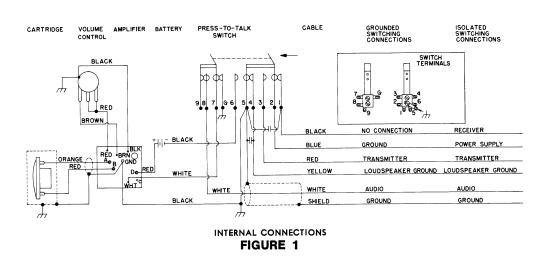Shure 526T User Manual

Model 526T Series II Super Punch
Microphone User Guide
TRANSISTORIZED BASE STATION MICROPHONE
GENERAL
The Shure Model 526T Series II SUPER PUNCH base station microphone is designed for clearer transmission and improved reliability. This transistorized microphone can be used to replace ceramic or dynamic, highor low-impedance microphones supplied as original equipment.
Model 526T Series II provides crisp, undistorted voice response with adjustable volume control for optimum intelligibility of transmission.
The microphone is designed for maximum versatility in base station operation. It has a momentary or locking press- to-talk transmit/receive switch for greatest ease of use, and a modulation level volume control for highest undistorted output with highor low-impedance inputs. The supplied sixwire cable and triple-pole double-throw switch are arranged for universal microphone-transceiver connection.
The microphone is not affected by heat or humidity, and it is oustanding in its ability to resist mechanical shocks and vibration. Its exclusive ARMO-DUR case is immune to oil, grease, fumes, salt spray, sun, rust, and corrosion. The “Million Cycle” leaf-type press-to-talk switch is designed to withstand rigorous operating conditions and constant use.
Microphone Features:
SDynamic microphone with transistorized preamplifier
SAdjustable volume control for optimum transmiter modulation and maximum intelligibility
SReplaces either ceramic or dynamic original equipment microphones
SExcellent response for single-sideband transmission
SUses readily available 9-volt battery—low current drain for long life
SLow hum pickup, minimum susceptibility to RF interference
SMomentary or locking press-to-talk transmit/receive switch –”Million Cycle” leaf-type
SUniversal six-wire cable for instant microphone-trans- ceiver connection
SSturdy, high-impact ARMO-DUR case
SRugged and dependable under all operating conditions
BATTERY INSTALLATION
Model 526T Series II uses a 9 Vdc battery (90AJ1371).To install the battery, proceed as follows:
1.Loosen two screws (located underneath base) holding battery retaining clip, and remove battery retaining clip.
2.Connect terminal strap to battery.
3.Insert battery in VELCRO strap of battery retaining cllip and fasten VELCRO strap.
4.Insert battery retaining clip in base and tighten screws securely.
CONNECTIONS
Model 527T Series II can be connected to an input (transceiver, transmitter, or amplifier) of 500 ohms or more. For detailed instructions for connecting the 526T Series II to CB or ham transceivers. If your unit is not listed in the Guide, contact your dealer or Shure Incorporated for information.
A piece of tubing is attached to the plug end of the cable for use as a strain relief for plugs with large cable entry holes. Remove the tubing when not required.
The internal connections of Model 526T Series II are as shown in Figure 1.
2001, Shure Incorporated
Printed in Mexico
27B1468 (AI)

9Vdc
The general wiring procedure for tranceiver connections is as follows:
Microphone Audio Input Circuit:
1.Connect the WHITE cable lead to the microphone audio input terminal.
2.Connect the SHIELD to chassis or circuit ground of the transceiver (see Guide and CAUTION
below).
Electronic or Relay Switching Circuit:
GROUNDED SWITCHING
Most transceivers employ a grounded circuit to switch from the receive to the transmit position. To connect the microphone to such a circuit, proceed as follows:
1.At the end of the cable, connect the RED lead to the terminal used to complete the transmitter circuit.
2.Connect the BLUE lead to chassis or circuit ground of the transceiver (see Guide and CAUTION below).
3.Connect the YELLOW lead to the terminal used to complete the receiver circuit. This will usually be a ground return from the loudspeaker circuit. If a microphone switching contact is not required for loudspeaker ground, insulate (wrap with tape) the YELLOW lead.
4.The BLACK lead is usually not used; insulate the BLACK lead. However, if both a receiver ground and a loudspeaker ground are required, connect the YELLOW lead to loudspeaker ground, and the BLACK lead to the receiver ground.
ISOLATED SWITCHING
In some transceivers, an isolated circuit is required to switch power supply voltages rather than grounds. If an isolated switching circuit is required, proceed as follows:
1.At the end of the cable, connect the RED lead to the isolated switch contact terminal used to complete the transmitter circuit.
2.Connect the BLUE lead to the terminal used for the switched power supply.
3.Connect the BLACK lead to the terminal used to complete the receiver circuit. If the power supply is not
switched to the receiver circuit by a microphone switching contact, insulate (wrap with tape) the BLACK lead.
4.Connect the YELLOW lead to the loudspeaker ground return. If a microphone switching contact is not required for the loudspeaker ground, insulate the YELLOW cable lead.
CAUTION
Make certain that the SHIELD and/or the BLUE lead are not connected to chassis ground for those models where the Guide specifies they should be connected to circuit ground.
SPECIAL SWITCHING
In some transceivers, special switching circuits are required. Three types are described below. In all of the types, before making the required circuit alterations, remove the microphone baseplate by unscrewing the two screws securing it.
1.If a grounded audio input is required in the receive mode, solder a jumper lead between switch terminal 9 and the ground lug (see Figure 1).
2.If both and isolated and grounded transmit circuit are required, along with a grounded receive circuit (see Figure 1):
a)Unsolder the WHITE leads from switch terminals 7 and 8.
b)Solder the WHITE leads together, and insulate the connection.
c)Cut the BLACK cable lead from terminal 1 and solder it to terminal 8.
d)Solder a jumper lead between terminal 7 and the ground lug.
At the end of the cable, the BLUE and RED leads are now the isolated transmit leads; the BLACK lead is the grounded transmit lead; and the YELLOW lead is the grounded receive lead.
3.If both an isolated and grounded receive circuit are required, along with a grounded transmit circuit (see Figure 1):
2
